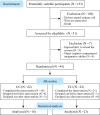Action observation and motor imagery have no effect on balance and freezing of gait in Parkinson's disease: a randomized controlled trial
- PMID: 36052889
- PMCID: PMC10019482
- DOI: 10.23736/S1973-9087.22.07313-0
Action observation and motor imagery have no effect on balance and freezing of gait in Parkinson's disease: a randomized controlled trial
Abstract
Background: Combining action observation (AO) and motor imagery (MI) training may induce greater brain activity in areas usually involved in Parkinson's disease (PD) and lead to greater behavioral and neurophysiological effects than when used separately.
Aim: To determine the effects of combining AO, MI, and gait training on balance and freezing of gait in individuals with PD.
Design: This is a single-blinded, randomized controlled clinical trial.
Setting: Laboratory of Intervention and Analysis of Movement (LIAM) from the Department of Physical Therapy of a Brazilian University.
Population: Study sample consisted of individuals diagnosed with idiopathic PD by a neurologist specialized in movement disorders.
Methods: 39 individuals with PD were divided into experimental (EG=21) and control groups (CG=18). EG performed 12 sessions of AO, MI, and gait training, whereas CG watched PD-related educational videos and performed 12 sessions of gait training. Balance (measured using the Mini Balance Evaluation Systems Test [MiniBESTest]) and freezing of gait (measured using the Freezing of Gait Questionnaire) were reassessed one day after the end of the intervention.
Results: We did not observe significant intra- and intergroup differences in freezing of gait. For the EG, we observed a significant intragroup difference in the total score of MiniBESTest (F=5.2; P=0.02), and sensory orientation (F=4.5; P=0.04) and dynamic gait (F=3.6; P=0.03) domains. MiniBESTest domains were not different between groups.
Conclusions: Combining AO, MI, and gait training was not more effective than isolated gait training for balance and freezing of gait in individuals with PD.
Clinical rehabilitation impact: MI training can moderate AO effects and enhance motor learning when both therapies are combined. Therefore, this approach may still have the potential to be included in the treatment of PD. New studies should investigate whether the factors that influence these results are related to the protocol's sensitivity in changing the evaluated parameters or to the time and intensity of AO and MI training.
Conflict of interest statement
Figures
Similar articles
-
The effectiveness of action observation and motor imagery in freezing of gait, speed, physical function and balance in Parkinson's disease: a systematic review and meta-analysis.Physiother Theory Pract. 2025 Jun;41(6):1297-1315. doi: 10.1080/09593985.2024.2404600. Epub 2024 Sep 19. Physiother Theory Pract. 2025. PMID: 39298350
-
Action Observation and Motor Imagery Improve Dual Task in Parkinson's Disease: A Clinical/fMRI Study.Mov Disord. 2021 Nov;36(11):2569-2582. doi: 10.1002/mds.28717. Epub 2021 Jul 19. Mov Disord. 2021. PMID: 34286884 Clinical Trial.
-
The feasibility and positive effects of a customised videogame rehabilitation programme for freezing of gait and falls in Parkinson's disease patients: a pilot study.J Neuroeng Rehabil. 2018 Apr 10;15(1):31. doi: 10.1186/s12984-018-0375-x. J Neuroeng Rehabil. 2018. PMID: 29636105 Free PMC article. Clinical Trial.
-
Effects of progressive resistance exercise in akinetic-rigid Parkinson's disease patients: a randomized controlled trial.Eur J Phys Rehabil Med. 2017 Oct;53(5):651-663. doi: 10.23736/S1973-9087.17.04572-5. Epub 2017 Mar 13. Eur J Phys Rehabil Med. 2017. PMID: 28290191 Clinical Trial.
-
Action Observation and Motor Imagery as a Treatment in Patients with Parkinson's Disease.J Parkinsons Dis. 2024;14(s1):S53-S64. doi: 10.3233/JPD-230219. J Parkinsons Dis. 2024. PMID: 38250785 Free PMC article. Review.
Cited by
-
Harnessing Mirror Neurons: A New Frontier in Parkinson's Disease Rehabilitation-A Scoping Review of the Literature.J Clin Med. 2024 Aug 2;13(15):4539. doi: 10.3390/jcm13154539. J Clin Med. 2024. PMID: 39124805 Free PMC article.
-
The inertial-based gait normalcy index of dual task cost during turning quantifies gait automaticity improvement in early-stage Parkinson's rehabilitation.J Neuroeng Rehabil. 2024 Sep 19;21(1):166. doi: 10.1186/s12984-024-01456-0. J Neuroeng Rehabil. 2024. PMID: 39300485 Free PMC article. Clinical Trial.
-
Exploring motor imagery as a therapeutic intervention for Parkinson's disease patients: a scoping review.Front Neurol. 2024 Nov 1;15:1422672. doi: 10.3389/fneur.2024.1422672. eCollection 2024. Front Neurol. 2024. PMID: 39555483 Free PMC article.
-
The use of brain-machine interface, motor imagery, and action observation in the rehabilitation of individuals with Parkinson's disease: A protocol study for a randomized clinical trial.PLoS One. 2025 Apr 7;20(4):e0315148. doi: 10.1371/journal.pone.0315148. eCollection 2025. PLoS One. 2025. PMID: 40193313 Free PMC article.
-
Personalized auditory cues improve gait in patients with early Parkinson's disease.Front Neurol. 2025 Jun 18;16:1561880. doi: 10.3389/fneur.2025.1561880. eCollection 2025. Front Neurol. 2025. PMID: 40606136 Free PMC article.
References
-
- World Health Organization (WHO). Neurological disorders: public health challenges. Neurological disorders: public health challenges 2006. p. 140-50.
-
- Grabli D, Karachi C, Welter ML, Lau B, Hirsch EC, Vidailhet M, et al. Normal and pathological gait: what we learn from Parkinson’s disease. J Neurol Neurosurg Psychiatry 2012;83:979–85. https://www.ncbi.nlm.nih.gov/entrez/query.fcgi?cmd=Retrieve&db=PubMed&l... 10.1136/jnnp-2012-302263 - DOI - PMC - PubMed
-
- Mirelman A, Bonato P, Camicioli R, Ellis TD, Giladi N, Hamilton JL, et al. Gait impairments in Parkinson’s disease. Lancet Neurol 2019;18:697–708. https://www.ncbi.nlm.nih.gov/entrez/query.fcgi?cmd=Retrieve&db=PubMed&l... 10.1016/S1474-4422(19)30044-4 - DOI - PubMed
-
- Kim SD, Allen NE, Canning CG, Fung VS. Postural instability in patients with Parkinson’s disease. Epidemiology, pathophysiology and management. CNS Drugs 2013;27:97–112. https://www.ncbi.nlm.nih.gov/entrez/query.fcgi?cmd=Retrieve&db=PubMed&l... 10.1007/s40263-012-0012-3 - DOI - PubMed
-
- Grimbergen YA, Langston JW, Roos RA, Bloem BR. Postural instability in Parkinson’s disease: the adrenergic hypothesis and the locus coeruleus. Expert Rev Neurother 2009;9:279–90. https://www.ncbi.nlm.nih.gov/entrez/query.fcgi?cmd=Retrieve&db=PubMed&l... 10.1586/14737175.9.2.279 - DOI - PubMed
Publication types
MeSH terms
LinkOut - more resources
Full Text Sources
Medical


